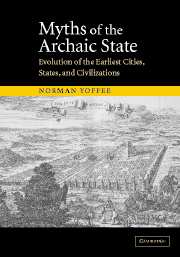Book contents
- Frontmatter
- Contents
- List of figures
- List of tables
- INTRODUCTION
- 1 THE EVOLUTION OF A FACTOID
- 2 DIMENSIONS OF POWER IN THE EARLIEST STATES
- 3 THE MEANING OF CITIES IN THE EARLIEST STATES AND CIVILIZATIONS
- 4 WHEN COMPLEXITY WAS SIMPLIFIED
- 5 IDENTITY AND AGENCY IN EARLY STATES: CASE STUDIES
- 6 THE COLLAPSE OF ANCIENT STATES AND CIVILIZATIONS
- 7 SOCIAL EVOLUTIONARY TRAJECTORIES
- 8 NEW RULES OF THE GAME
- 9 ALTERED STATES: THE EVOLUTION OF HISTORY
- Acknowledgments
- References
- Index
4 - WHEN COMPLEXITY WAS SIMPLIFIED
Published online by Cambridge University Press: 22 September 2009
- Frontmatter
- Contents
- List of figures
- List of tables
- INTRODUCTION
- 1 THE EVOLUTION OF A FACTOID
- 2 DIMENSIONS OF POWER IN THE EARLIEST STATES
- 3 THE MEANING OF CITIES IN THE EARLIEST STATES AND CIVILIZATIONS
- 4 WHEN COMPLEXITY WAS SIMPLIFIED
- 5 IDENTITY AND AGENCY IN EARLY STATES: CASE STUDIES
- 6 THE COLLAPSE OF ANCIENT STATES AND CIVILIZATIONS
- 7 SOCIAL EVOLUTIONARY TRAJECTORIES
- 8 NEW RULES OF THE GAME
- 9 ALTERED STATES: THE EVOLUTION OF HISTORY
- Acknowledgments
- References
- Index
Summary
A state evolves from agriculture to paradox.
e. m. cioranIn the early history of the first cities, states, and civilizations, differentiated social groups became recombined in cities. These cities were nodal points of pilgrimages, exchange, storage and redistribution, and centers for defense and warfare. In these cities, along with their associated and restructured countrysides, new identities as citizens were created but did not entirely supplant existing identities as members of economic, kin, and ethnic groups. Certain aspects of identity were also forged with citizens in other cities who shared a common, if created, heritage, and these were maintained and reproduced over time.
In the earliest cities, new rituals and ceremonies connected rulers with citizens and the gods. These displayed and justified the supremacy and legitimacy of kings and reaffirmed command over the social order. The social roles and practices of citizens were routinized within the urban layout of monumental constructions, streets and pathways, walls and courtyards. The built environment itself demonstrated the superior access to knowledge and planning held by rulers, ostensibly on behalf of all. Statecraft in the earliest cities involved providing an order to the present, which the rulers relentlessly proclaimed in literature and in a created landscape that overlay the unruliness of a society composed of many groups, each with its own interests and orientations.
Archaeologists commonly use the shorthand “complex society” to describe a society that encompasses numerous social groups and institutions of centralization.
- Type
- Chapter
- Information
- Myths of the Archaic StateEvolution of the Earliest Cities, States, and Civilizations, pp. 91 - 112Publisher: Cambridge University PressPrint publication year: 2005



